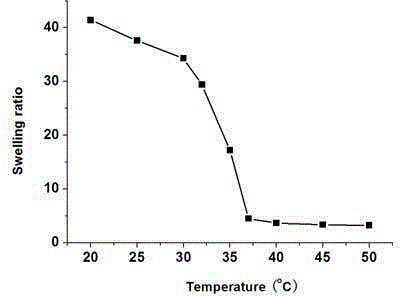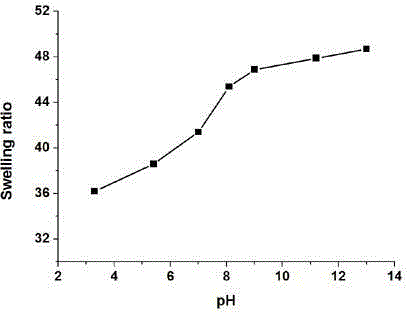Preparation method of temperature, pH and ultraviolet multi-stimuli-responsive semi-interpenetrating network nanocomposite hydrogel
A semi-interpenetrating network and nano-composite technology, which is applied in the field of preparation of smart gels, can solve problems such as inability to compound, high hydrophilicity requirements, and difficulties in multi-response nano-composite gels.
- Summary
- Abstract
- Description
- Claims
- Application Information
AI Technical Summary
Problems solved by technology
Method used
Image
Examples
Embodiment 1
[0030] Dissolve 3.6g of 4-(4-hydroxyphenylazo)benzoic acid in 100mL of anhydrous tetrahydrofuran, add 3.5mL of triethylamine, mix well, place in an ice-water bath to cool for 30 minutes, and slowly add 5mL of acryloyl chloride diluted with 60mL of anhydrous tetrahydrofuran, reacted at room temperature for 24h after dripping, added water to precipitate the product, filtered to obtain a crude product, washed with distilled water until neutral, and obtained a yellow powdery solid. Dissolve the yellow powdery solid in 120mL tetrahydrofuran, slowly adjust the pH of the system to 7 with aqueous sodium bicarbonate, stir at room temperature for 24 hours, precipitate with dilute aqueous hydrochloric acid, filter to obtain a yellow solid, wash with distilled water until neutral, and obtain a pure product , The yield is 92%. (back example all adopts this method to prepare this monomer)
[0031] Dissolve 4g of NIPA, 0.17g of 4-[(4-acryloyloxy)phenylazo]benzoic acid, 0.96g of lithium diat...
Embodiment 2
[0033] Dissolve 4g of NIPA, 0.22g of 4-[(4-acryloyloxy)phenylazo]benzoic acid, 1.22g of lithium diatomaceous earth, and 0.094g of sodium pyrophosphate in 40g of water and place it in a container at 0°C under nitrogen protection. Stir in an ice bath for 120 minutes until uniform and transparent, then add 0.6g of CMC, and continue stirring for 2 hours to obtain a uniform and transparent pre-polymerization solution; dissolve 0.04g of KPS and 0.03g of TEMED in 2g of water, stir well and add to the pre-polymerization solution, under nitrogen protection Stir rapidly for 2 minutes until uniform; then pour into a mold of a certain shape and react at 0°C for 24 hours, and then react at room temperature for 24 hours. After the obtained gel is taken out, the product is obtained by soaking and changing water repeatedly in deionized water.
Embodiment 3
[0035] 4.5g NIPA, 0.2g 4-[(4-acryloyloxy) phenyl azo] benzoic acid, 2.1g lithium diatomaceous earth, 0.161g sodium pyrophosphate were dissolved in 45g water and placed in a container, under nitrogen protection at 0 Stir in an ice bath for 120 minutes until uniform and transparent, then add 0.8g of CMC, and continue to stir for 2 hours to obtain a uniform and transparent pre-polymerization solution; dissolve 0.045g of KPS and 0.034g of TEMED into 2.25g of water, stir well and add to the pre-polymerization solution, nitrogen Stir quickly under protection for 2 minutes until uniform; then pour into a mold of a certain shape and react at 0°C for 24 hours, and then react at room temperature for 24 hours. After the obtained gel is taken out, the product is obtained by soaking and changing water repeatedly in deionized water.
PUM
 Login to View More
Login to View More Abstract
Description
Claims
Application Information
 Login to View More
Login to View More - R&D
- Intellectual Property
- Life Sciences
- Materials
- Tech Scout
- Unparalleled Data Quality
- Higher Quality Content
- 60% Fewer Hallucinations
Browse by: Latest US Patents, China's latest patents, Technical Efficacy Thesaurus, Application Domain, Technology Topic, Popular Technical Reports.
© 2025 PatSnap. All rights reserved.Legal|Privacy policy|Modern Slavery Act Transparency Statement|Sitemap|About US| Contact US: help@patsnap.com



